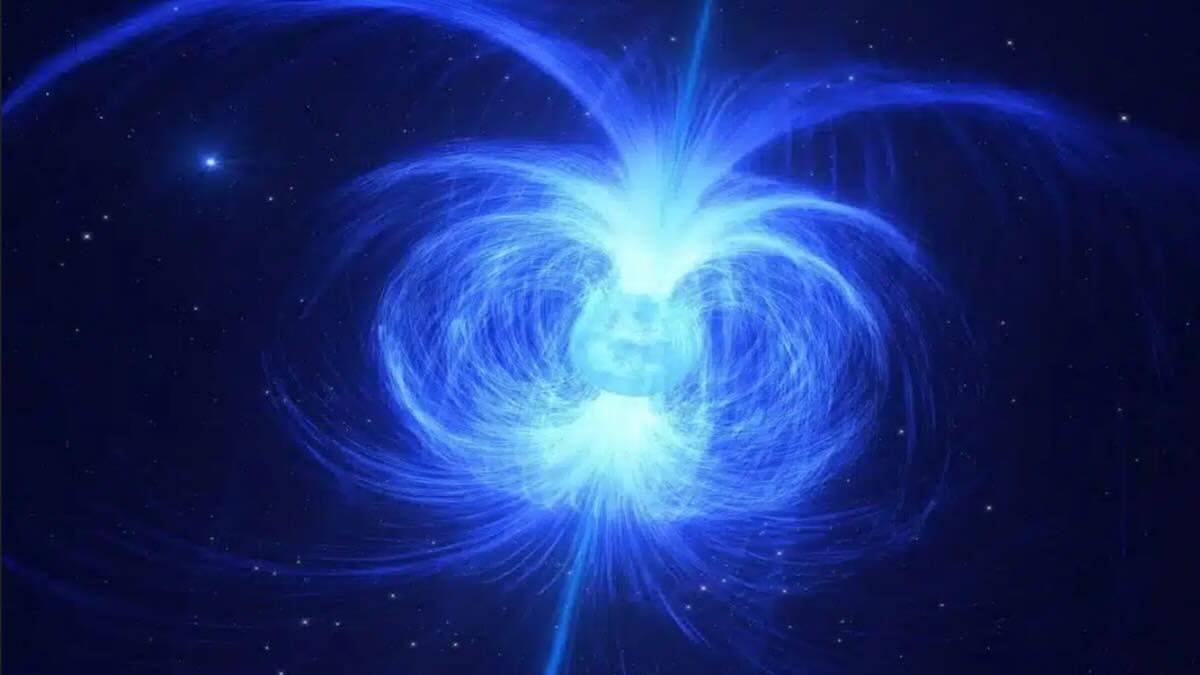A momentary burst from a magnetar within the Sculptor Galaxy journeyed 13 million light-years before contacting our detection equipment. During April 15, 2020, the Atmosphere–Space Interactions Monitor (ASIM) positioned on the International Space Station documented a colossal eruption persisting merely 0.16 seconds—nonetheless matching the energy production of a billion stellar bodies. The transmission diminished nearly instantly, though the observation remains: an exceptional occurrence from an intensely magnetized neutron star, recorded precisely and currently transforming our understanding regarding these turbulent cosmic powerhouses of radiation.
What actually happened in Sculptor Galaxy
ASIM detected a sudden spike in high-energy radiation from a compact, ultra-dense star : a magnetar, which is a neutron star wrapped in a magnetic field trillions of times stronger than Earth’s. The flare’s rise and decay were over in a heartbeat—0.16 seconds—followed by a rapid fall toward background levels. Despite the brevity, the power involved was immense, comparable to a billion solar outputs at once. Seen today, the flash left the Sculptor Galaxy roughly 13 million years ago, so we are reading a page from deep cosmic history. According to the ASIM team’s reporting, this was a textbook example of a “giant flare,” a rare class distinct from routine magnetar bursts and of keen interest to high-energy astrophysics.
Why a magnetar is no ordinary neutron star
Neutron stars already compress greater mass than our Sun within an urban-scale sphere. A magnetar extends beyond: its magnetic forces can contort the surface until structural failure occurs, discharging energy through a momentary, intense explosion that surpasses complete galactic luminosity for an instant.
How a magnetar unleashes energy in a blink
The leading picture is mechanical stress meeting magnetic fury. As the field lines shear and reconnect, they drive currents and heat that rupture the star’s rigid outer crust. That fracture couples to the magnetic field, producing an explosive release of high-frequency photons. In Sculptor’s case, the rise time and fade suggest a compact region and a violent trigger. On timescales shorter than a blink, the magnetar dumped more output than stars do across eons—then fell quiet again, leaving only a clean, decaying tail for instruments to parse and compare with past flares.
Crustquakes and magnetic reconnection explained
Imagine a rigid shell under relentless magnetic torque. When the strain exceeds the crust’s limit, it cracks—a “crustquake.” At the same time, tangled magnetic loops snap and rejoin (reconnection), converting stored magnetic tension into radiation and particle acceleration. That two-step chain fits the fast rise and sharp decay seen in giant flares.
Where it sits among gamma-ray bursts and supernovae
Gamma-ray bursts can last longer and often involve collapsing massive stars or merging neutron stars. Supernovae outshine galaxies for days or weeks. A magnetar giant flare is shorter and more localized, yet its peak output can be competitive, making it a compact, repeatable lab for extreme physics.
What this means for astronomy and for us
Occurrences like this provide scientists a structured method to examine theories of matter beneath extreme gravitational forces and extraordinary magnetic conditions. Since the burst remains extremely brief yet luminous, it demands observatories to synchronize: orbital detectors identify the initial signal, while terrestrial telescopes pursue any subsequent emissions throughout electromagnetic wavelengths. For audiences, the narrative appears simple yet remarkable: a stellar remnant matching urban dimensions can temporarily saturate space with energy equivalent to combined galactic radiance. Every observation, including ASIM’s 2020 detection, improves our calculations of eruption frequencies, standard intensities, and circumstances that shift a magnetar from stressed to fractured. This also clarifies instrumental development goals—swifter activation, enhanced temporal precision, and broader monitoring arrays to prevent overlooking the subsequent pulse-duration explosion.
Numbers in context and open questions
The flare lasted 0.16 seconds and carried the punch of about a billion suns. Another comparison the literature often uses helps with scale: a single giant flare can approximate the Sun’s output over 100,000 years, compressed into an instant. According to ASIM’s record, the signal’s quick fade suggests a compact emission zone and efficient cooling, but uncertainties remain. How often do magnetars enter this unstable state? Which conditions—field strength, age, local environment—prime them for rupture? And how many such flashes have we missed because we lacked the timing precision or all-sky coverage to see them?
Limits of what we know so far
We do not yet have a complete trigger recipe. Competing models weigh how much comes from crust failure versus magnetospheric reconnection, and how those pieces couple. Better statistics, from more events and faster detectors, will be the path forward.
Where we go from a 0.16-second flash
Giant flares are brief, but they are generous with clues. The Sculptor event confirms that magnetars can release staggering energy on humanly impossible timescales, and that modern instruments can catch and time those pulses cleanly. Next steps are practical: maintain wide-field monitors in orbit, keep rapid-response protocols ready on the ground, and compare future flares against this benchmark. Each new detection tightens the physics and brings us closer to a full, testable map of how magnetars store and unleash energy.
What to do now
If you follow space science, watch for coordinated alerts from orbital gamma-ray detectors and quick-turn optical or radio follow-ups. If you work in outreach, translate the numbers—0.16 seconds, a billion suns, 13 million light-years—into visuals your audience can grasp. For students, review neutron-star structure and magnetic reconnection; then compare giant flares with gamma-ray bursts and supernovae to understand where each phenomenon fits.
